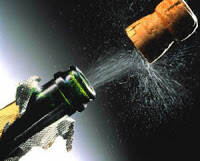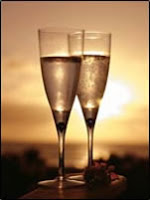Whew! We all enjoyed a wonderful Christmas and shifted immediately into after-Christmas shopping – no wait, that’s not right. We shifted into preparation for New Year’s Eve. So as we get ready for a night of revelry,
it is only right that we raise our glasses to the most honored of New Year’s
traditions: the champagne toast!
California will probably not be actually toasting with Champagne. Purists (and
French lawyers) insist that champagne only comes from the Champagne region in
France. So fine, we’ll be politically correct for once and call it sparkling
wine. There, are you happy? But we will pour our California sparkling wine into champagne
flutes and ring in the new year in fine style.
New Year’s Eve has been celebrated for over 4,000 years
(on one date or another. Thanks, Julius). Different eras and different cultures
have different ways to celebrate the ceremonial transition from one year to the
next, but around here, we serve champagne every New Year’s. Full disclosure: we
also serve champagne for other important events, like having Sarah drop by, or
Judi having a particularly good day, or… pretty much anything else, I won’t
lie.
created by Benedictine monks in the mid-1500’s. Many people will tell you that Dom
Pérignon invented champagne, but he came along years later and improved on an existing process that
allowed the monks to reliably produce champagne in volume. The bottles that bear his
name are delicious, though. For the most part, though, we are a Korbel
household. Big fans, Guerneville, big fans! If you haven’t visited the Korbel
winery, it is well worth a trip.
One of the few things that can take away from a wonderful
New Year’s Eve celebration is a botched bottle opening. The movie stereotype of
a champagne cork flying across the room and the bubbly wonderfulness gushing
all over the floor is definitely NOT the right approach. The tiny bit of remaining
champagne will be flat. Some guest will be rubbing their wound and muttering
about looking up their lawyer’s number. There is a better way!
 First, remove the plastic/foil wrapper that covers the
First, remove the plastic/foil wrapper that covers thechampagne cork. Then untwist the wire cage that binds the cork to the neck of
the bottle. Remember that the bottle is now a dangerous instrument. Do not
point it at anyone who you even remotely like. The cork can fly out without a
bit of notice. It hurts. Trust me. My personal best for cork flight is 24 feet,
so believe that there is some serious pressure in champagne bottles. Treat it
with care.
Once the wire cage is removed, slowly (and I mean SLOWLY)
twist the cork. Don’t pull the cork, or push the cork up with your thumbs. You’re
trying to make the cork come out a slowly as you can. The twisting will result
in the cork moving up the neck of the bottle, driven by the pressure within.
Some corks are very tight, so many times I wrap a dish towel around the cork to
get a better grip. Other people use the wire cage over the cork for grip, but I
find that the wire can slice my soft office-worker hands.
be rewarded with a very gentle “pop” and a bit of mist as the cork leaves the
bottle. If any actual champagne comes out, it means that you were too impetuous
and rushed the process. Feel bad about the wasted champagne that will never
find its rightful place in your glass.
pouring. We prefer tall, narrow flutes for champagne (ever notice the masthead
image?) because the bubbles stay in the wine until they reach the mouth. Those wide-brimmed champagne glasses are pretty, but the bubbles disappear pretty
fast. It’s a surface area thing. Ask an engineer, they are always ready to
explain anything, no matter how boring.
to welcome the new year.
About the Author: John grills a mean steak and is always in the market for another wine fridge. Believes that if a winery has more than 10 employees, it's probably too big. Buys wine faster than he drinks it, but who cares?





